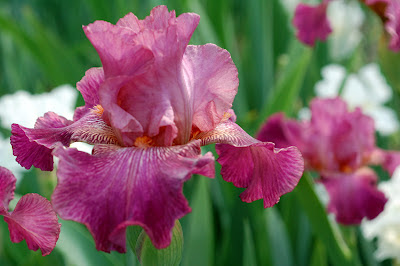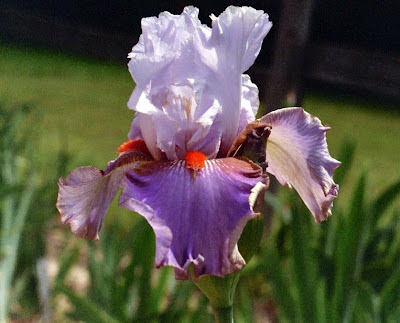By Ron Killingsworth
Iris lovers are always asking me to name my favorite iris. That is hard to do when you have so many. I have never been able to pin it down to just one favorite so I though I would share with you some of the irises that are in the running.
 |
| 'Amber River' by Richard Sloan (1984) |
|
I'll start with an iris by Richard Sloan, a close friend in Bossier City, LA, who has produced many beautiful irises.
'Amber River' has nice colors, is a good garden iris, and I really like the form and the style arms.
 |
| 'Atchafalaya' by Farron Campbell (1988) |
|
Farron Campbell is a former president of the
Society for Louisiana Irises and hybridized many exceptional irises. I like
'Atchafalaya' (Ugh chaf ugh lie ugh) because of the "Louisiana" name and the "cartwheel" form, as well as the vivid color. It also has a "halo" around the edge of the petals. We have a large bed of this iris and when it is in bloom it really puts on a show.
 |
| 'Creole Can Can' by Marvin Granger (1956) |
|
Marvin Granger discovered a cartwheel form iris in the wild in the marshes of south LA and collected it. He crossed the iris and produced several more "cartwheel form" irises. I really like the name
'Creole Can Can' and the beautiful blue color of the iris. You will seldom find two blooms of this iris that are the same. Another beautiful cartwheel form by Marvin is '
Starlite Starbrite', a really nice white iris.
 |
| 'Creole Rhapsody' by Joe Mertzweiller (1998) |
Joe Mertzweiller was a college professor and he hybridized over thirty registered LA irises. If someone held a gun to my head and said "pick a favorite iris or die!" I would have to pick '
Creole Rhapsody' because it has huge blooms and the coloring is just out of this world! Of course the name is just right for a LA iris.
 |
| 'Edna Claunch' by Harry Wolford (2004) |
The iris
'Edna Claunch' has won many awards and is truly a lovely veined lime green iris, tending to fade to a lovely yellow.Edna Claunch (the real person) is a member of the board of the Society for Louisiana Irises and lives in Rochester, NY, where she was part of a group that planted a mass of LA irises in a friendship garden. It amazes me that these LA irises spend their winter under many feet of snow. Harry Wolford, the hybridizer of this iris, is a retired educator and lives in Palm Bay, FL. Harry is past president of SLI.
 |
| 'Enviable' by M. D. Faith (2002) |
M. D. Faith is retired, and living in a small town near Little Rock, AR. He has produced many beautiful LA irises and is a long time member of SLI. This iris has some unusual colors and is really an eye catcher in the garden.
 |
| 'Extra Dazzle' by Heather Pryor (2003) |
|
Heather Pryor and her husband Bernard have produced many beautiful LA irises from their commercial iris garden in Australia. I love the "sun ray" spray and signals on all the petals. The lime style arms really stand out.
 |
| 'Flash Harry' by Penny Davis (2008) |
Penny Davis is another Australian hybridizer and although she has introduced only a few irises in the US, she has many of her hybridized irises growing in her native country. This is just a lovely colored (coloured) iris that is sort of wine red.
 |
| 'Gertie Butler' by Charles Arny (1989) |
Charles Arny produced over 130 registered LA irises during his life-time. He won many awards for his irises and was a charter member of SLI. This iris has a beautiful white spray pattern on the falls. Another iris with this pattern is
'C'est Si Bon' (J. C. Tayor, 1983), which is a little darker color than
'Gertie Butler'.
 |
| 'Heather Pryor' by J. C. Taylor (1993) |
J. C. Taylor, another hybridizer from Australia, registered over 200 LA irises. He named this beautiful pink iris for his fellow Australian hybridizer, Heather Pryor. This iris is definitely in my top 10!
 |
| 'Honey Star' by Janet Hutchinson (1991) |
I have a large clump of
'Honey Star' and it puts on a show for me every spring. Janet Hutchinson also lives in Australia and has hybridized and registered over 30 LA irises.
 |
| 'Hope and Glory' by Richard Sloan (2008) |
We have been growing and introducing irises registered by Richard Sloan and have enjoyed seeing his latest irises each spring. I love the name '
Hope and Glory' and the flower is really a beauty with the white standards.
 |
| 'Kentucky Thoroughbred' by W. Bruner (2002) |
I am not really acquainted with Mr. Bruner but I love this tetraploid iris. The spray pattern around the signals is a feature I enjoy in irises. There are not many tetraploid LA irises and this one stands out in the garden.
 |
| 'Mighty Rich' by Charles Arny (1982) |
'Mighty Rich' is a beautiful large iris with an eye catching signal. It may be an oldie but it is still a goodie!
 |
| 'Our Parris' by C. Carroll (1987) |
I am not familiar with C. Carrol but think she is also from Australia. I love this iris because of the unusual color which is registered as "cream ground with peach to dusty peach overtones."
So, friends, I ask you, how can anyone decide that one of these irises is prettier than the others? See if you can pick yourself a "favorite" from the irises here and leave a comment about why you like this one so much.
To learn more about irises of all sizes, shapes and descriptions, visit the web site of the
American Iris Society or visit the
Iris Encyclopedia to view many more pictures of irises.







































